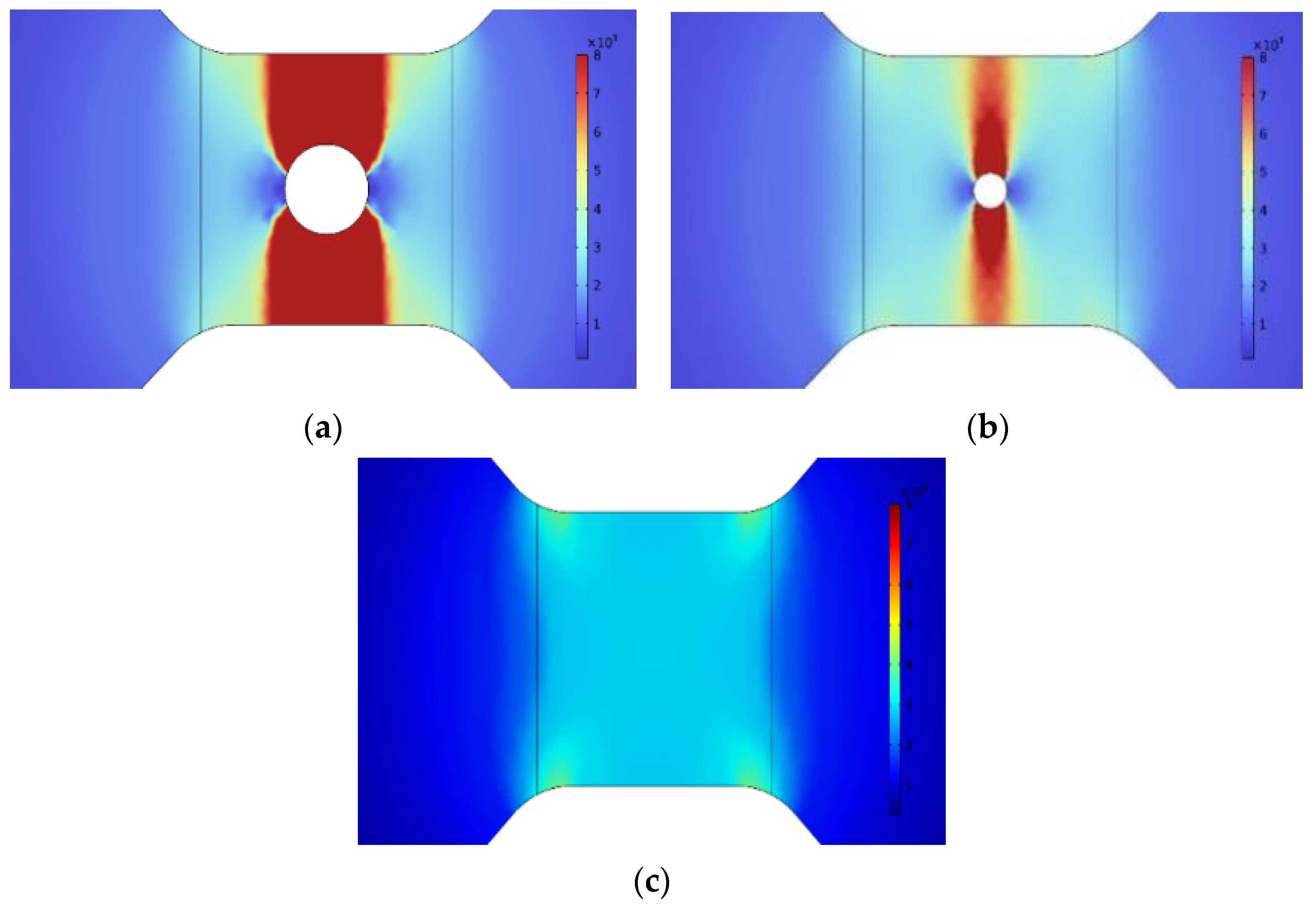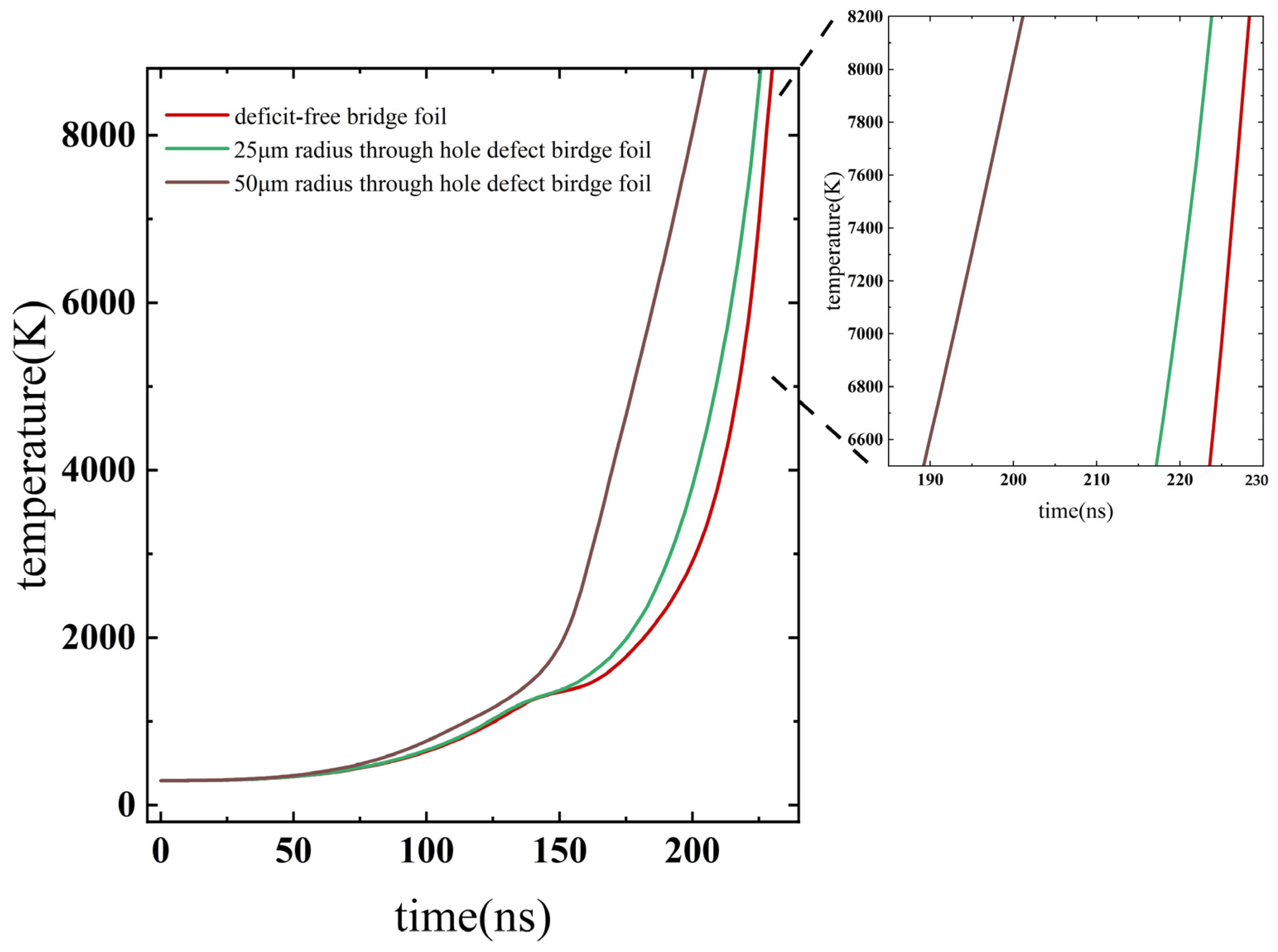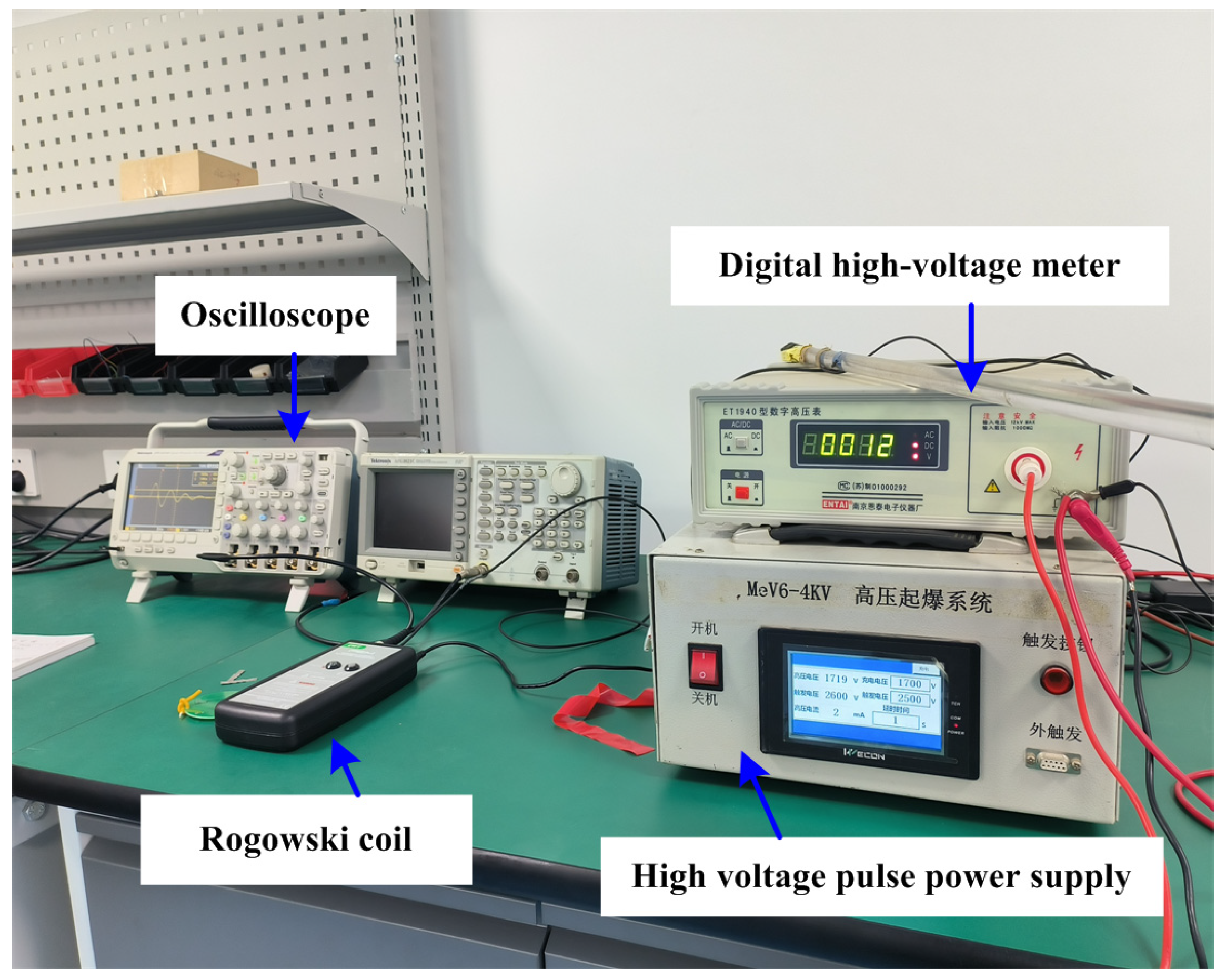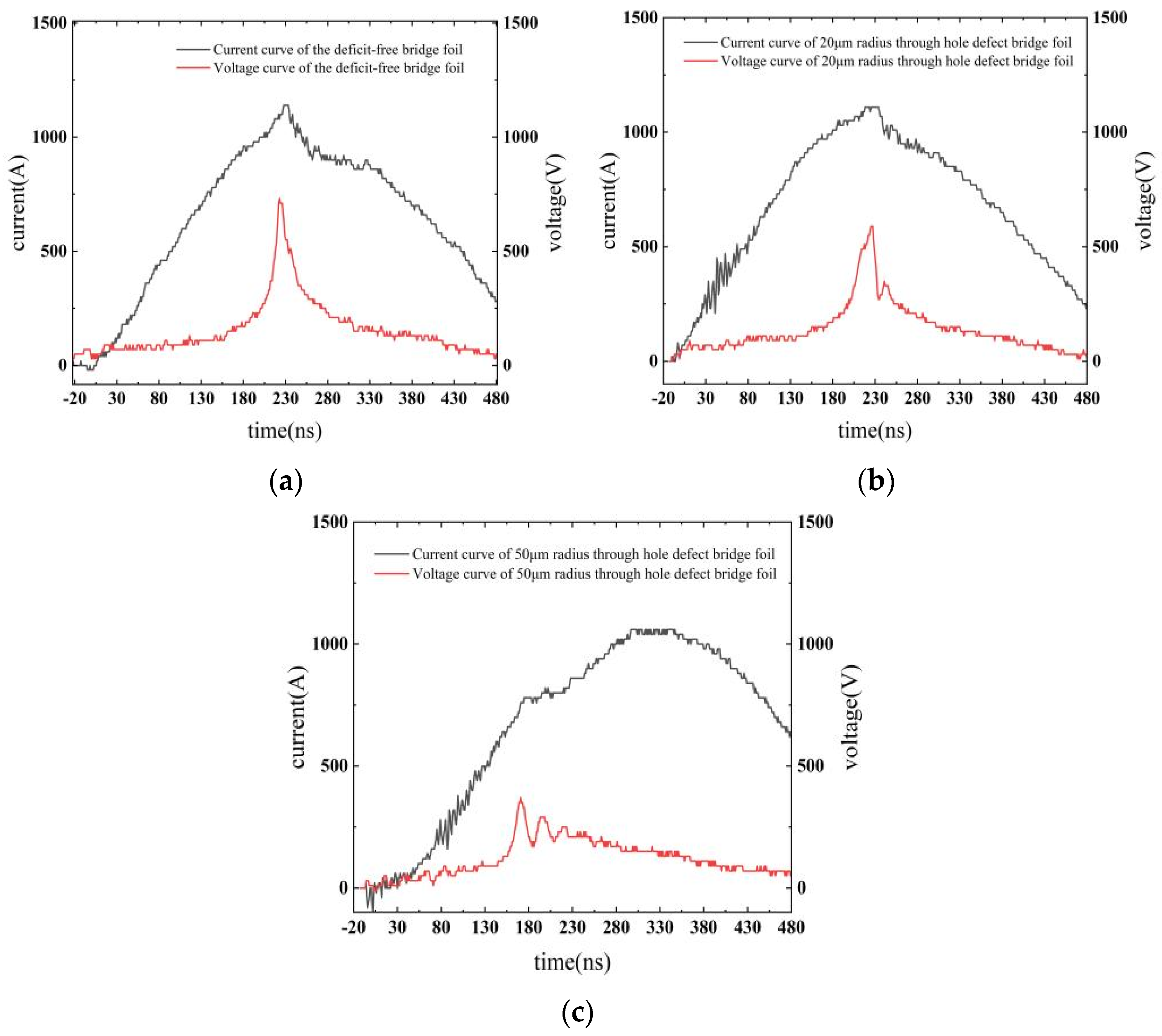Impact of Through-Hole Defects on the Electro-Explosive Properties of Exploding Foil Transducers
Abstract
:1. Introduction
2. Theories and Numerical Simulations
2.1. Bridge Foil Electro-Thermal Conversion Theory
2.2. Bridge Foil Electro-Thermal Conversion Simulations
2.3. Calculations of Bridge Foil Current and Voltage
2.4. Analysis of Simulation Results
3. Experiment and Results
4. Conclusions
- (1)
- Through-hole defects lead to an advancement in the explosion time, and the size of the through-hole determines the extent of this advancement. The relationship between the through-hole radius and the bridge foil explosion time follows a quadratic function.
- (2)
- Through-hole defects significantly reduce the transduction efficiency of the bridge foil transducer element during electrical explosion.
- (3)
- Specifically, when the through-hole radius is 20 μm, the through-hole defect causes the bridge foil explosion time to advance by 1 ns, and the energy conversion efficiency is reduced by 1.52%. When the through-hole radius increases to 50 μm, the through-hole defect leads to a 51 ns advancement in the bridge foil explosion time and a 13.96% reduction in the energy conversion efficiency. When the structure of the bridge area or the size of the through-hole changes, the values of the explosion time advance and the energy conversion definitely will vary; the specific values need to be further determined through simulations and experiments.
Author Contributions
Funding
Data Availability Statement
Conflicts of Interest
References
- Smit, K.J.; Morgan, M.; Pietrobon, R. Pyrotechnic films based on thermites covered with PVC. Propellants Explos. Pyrotech. 2019, 44, 37–40. [Google Scholar] [CrossRef]
- Stroud, J.R. A New Kind of Detonator the Slapper; Lawrence Livermore National Lab: Livermore, CA, USA, 1976. [Google Scholar]
- Xu, C.; Zhu, P.; Zhang, W.; Shen, R.; Ye, Y. A plasma switch induced by electroexplosion of p-n junction for mini exploding foil initiator. IEEE Trans. Plasma Sci. 2019, 47, 2710–2716. [Google Scholar] [CrossRef]
- Zhang, Q.; Xu, C.; Zhu, P. Planar trigger switch and its integrated chip with exploding foil initiator based on low-temperature cofired ceramic. IEEE Trans. Power Electron. 2019, 35, 2908–2916. [Google Scholar] [CrossRef]
- Zhi, Y.; Peng, Z.; Qing, C. A micro-chip exploding foil initiator based on printed circuit board technology. Def. Technol. 2022, 18, 1435–1444. [Google Scholar]
- Sun, L.; Zhan, Z.; Wu, Z. Optimizing cure temperature of polyimide flyer for exploding foil initiator applications. J. Appl. Polym. Sci. 2022, 139, e53072. [Google Scholar]
- Wu, J.; Wang, L.; Li, Y.; Yang, L.; Sultan, M.; Chen, L. Characteristics of a plasma flow filed produced by a metal array bridge foil explosion. Plasma Sci. Technol. 2018, 20, 075501. [Google Scholar] [CrossRef] [Green Version]
- Wang, K.; Zhu, P.; Xu, C.; Zhang, Q.; Yang, Z.; Shen, R. Firing performance of microchip exploding foil initiator triggered by metal-oxide-semiconductor controlled thyristor. Micromachines 2020, 11, 550. [Google Scholar] [CrossRef] [PubMed]
- Hwang, H.J.; Kim, D.J.; Jang, Y.R.; Hwang, Y.T.; Jung, I.H.; Kim, H.S. Multi-pulsed flash light sintering of copper nanoparticle pastes on silicon wafer for highly-conductive copper electrodes in crystalline silicon solar cells. Appl. Surf. Sci. 2018, 462, 378–386. [Google Scholar] [CrossRef]
- Li, D.; Li, S.; Wang, K.; Cheng, J.; Wang, J.; Wu, S.; Su, J. Study of the explosive bridge film using laser shaping technology. Micromachines 2022, 13, 854. [Google Scholar] [CrossRef] [PubMed]
- Madhavi, G.; Kishan, N.; Raghavendra, C.R. A review on recent approaches in the field of surface coating. Mater. Today Proc. 2022, 52 Pt 3, 403–406. [Google Scholar] [CrossRef]
- Sanchez, N.; Neal, W.; Jensen, B. Dynamic initiator imaging at the advanced photon source: Understanding the early stages of initiator function and subsequent explosive interactions. In Proceedings of the 20th Biennial Conference of the APS Topical Group on Shock Compression of Condensed Matter, St. Louis, MO, USA, 9–14 July 2017; American Physical Society: College Park, MD, USA, 2017. [Google Scholar]
- Neal, W.; Bowden, M. High fidelity studies of exploding foil initiator bridges, Part 2: Experimental results. In AIP Conference Proceedings; AIP Publishing LLC: Melville, NY, USA, 2017; Volume 1793. [Google Scholar]
- Neal, W.; Garasi, C. High fidelity studies of exploding foil initiator bridges, Part 3: Alegra MHD simulations. In AIP Conference Proceedings; AIP Publishing LLC: Melville, NY, USA, 2017; Volume 1793. [Google Scholar]
- Neal, W.; Sanchez, N.; Jensen, B. The effect of surface heterogeneities in exploding metal foils. In AIP Conference Proceedings; AIP Publishing LLC: Melville, NY, USA, 2018; Volume 1979. [Google Scholar]
- Costa, M.Y.P.; Venditti, M.L.; Cioffi, M.O.H. Fatigue behavior of PVD coated Ti-6Al-4V alloy. Int. J. Fatigue 2011, 33, 759–765. [Google Scholar] [CrossRef] [Green Version]
- Panjan, P.; Čekada, M.; Panjan, M. Surface density of growth defects in different PVD hard coatings prepared by sputtering. Vacuum 2012, 86, 794–798. [Google Scholar] [CrossRef] [Green Version]
- Zhao, Y.; Zeng, Q.; Feng, C. Theoretical model for calculating electric-power curves depicting accelerated flyer by exploding foil. J. Beijing Inst. Technol. 2010, 19, 8–13. [Google Scholar]
- Guru, B.S.; Hiziroğlu, H.R. Electromagnetic Field Theory Fundamentals, 2nd ed.; Cambridge University Press: New York, NY, USA, 2004. [Google Scholar]
- Chu, E.; Liu, W.; Xue, Y.; Zhang, R. Study on parametrized structural design of micro-heater and its resistance calculation. Initiat. Pyrotech. 2017, 6, 1–5. [Google Scholar]
- Guo, F.; Fu, Q.; Wang, Y.; Wang, M.; Huang, H.; Shen, R. Effects of fabrication process on drive capability of flyer with copper bridge foil. Chin. J. Energetic Mater. 2015, 23, 787–790. [Google Scholar]
- Zhou, M.; Zhang, J.; Tong, H.; Qin, G.; Li, J.; Wang, Y. Study on the effect of copper foil thickness on detonation performance of explosive foil initiator. Initiat. Pyrotech. 2019, 4, 14–18. [Google Scholar]
- Li, D.; Zhang, W.; Li, S. Secondary ignition of carbon-based bridge coating triggered by low voltage. Mater. Res. Express 2021, 8, 045607. [Google Scholar]
- Ying, G.F.; Li, X.W.; Jia, S.L. Electrical characteristics of microsecond electrical explosion of Cu wires in air under various parameter. Trans. Plasma Sci. 2018, 46, 972–981. [Google Scholar]
- Lee, Y.T.; More, R.M. An electron conductivity model for dense plasma. Phys. Fluids 1984, 27, 1273–1286. [Google Scholar] [CrossRef]








| Defect Size | Explosion Time/ns | Deposited Energy/mJ | Capacitive Energy Storage/mJ |
|---|---|---|---|
| Defect-free bridge foil | 227 | 62.86 | 133.10 |
| 20 μm radius through-hole defect | 223 | 62.26 | 133.10 |
| 50 μm radius through-hole defect | 199 | 49.39 | 133.10 |
| Defect Size | Parameters | Experimental Values | Calculated Values | Relative Errors |
|---|---|---|---|---|
| defect-free bridge foil | Outbreak time/ns | 226 | 227 | 0.44% |
| Deposited energy/mJ | 62.15 | 62.86 | 1.13% | |
| Energy conversion efficiency | 46.69% | 47.23% | 1.14% | |
| 20 μm through-hole bridge foil | Outbreak time/ns | 225 | 223 | −0.90% |
| Deposited energy/mJ | 60.12 | 62.26 | 3.43% | |
| Energy conversion efficiency | 45.17% | 46.78% | 3.44% | |
| 50 μm through-hole bridge foil | Outbreak time/ns | 175 | 199 | 12.06% |
| Deposited energy/mJ | 43.56 | 49.39 | 11.80% | |
| Energy conversion efficiency | 32.73% | 37.11% | 11.80% |
Disclaimer/Publisher’s Note: The statements, opinions and data contained in all publications are solely those of the individual author(s) and contributor(s) and not of MDPI and/or the editor(s). MDPI and/or the editor(s) disclaim responsibility for any injury to people or property resulting from any ideas, methods, instructions or products referred to in the content. |
© 2023 by the authors. Licensee MDPI, Basel, Switzerland. This article is an open access article distributed under the terms and conditions of the Creative Commons Attribution (CC BY) license (https://creativecommons.org/licenses/by/4.0/).
Share and Cite
Wang, K.; Wang, J.; Li, X.; Li, D.; Cheng, J.; Wang, J.; Wu, S. Impact of Through-Hole Defects on the Electro-Explosive Properties of Exploding Foil Transducers. Micromachines 2023, 14, 1499. https://doi.org/10.3390/mi14081499
Wang K, Wang J, Li X, Li D, Cheng J, Wang J, Wu S. Impact of Through-Hole Defects on the Electro-Explosive Properties of Exploding Foil Transducers. Micromachines. 2023; 14(8):1499. https://doi.org/10.3390/mi14081499
Chicago/Turabian StyleWang, Kexuan, Jiangxu Wang, Xinyu Li, Dangjuan Li, Junxia Cheng, Jia Wang, and Shenjiang Wu. 2023. "Impact of Through-Hole Defects on the Electro-Explosive Properties of Exploding Foil Transducers" Micromachines 14, no. 8: 1499. https://doi.org/10.3390/mi14081499





